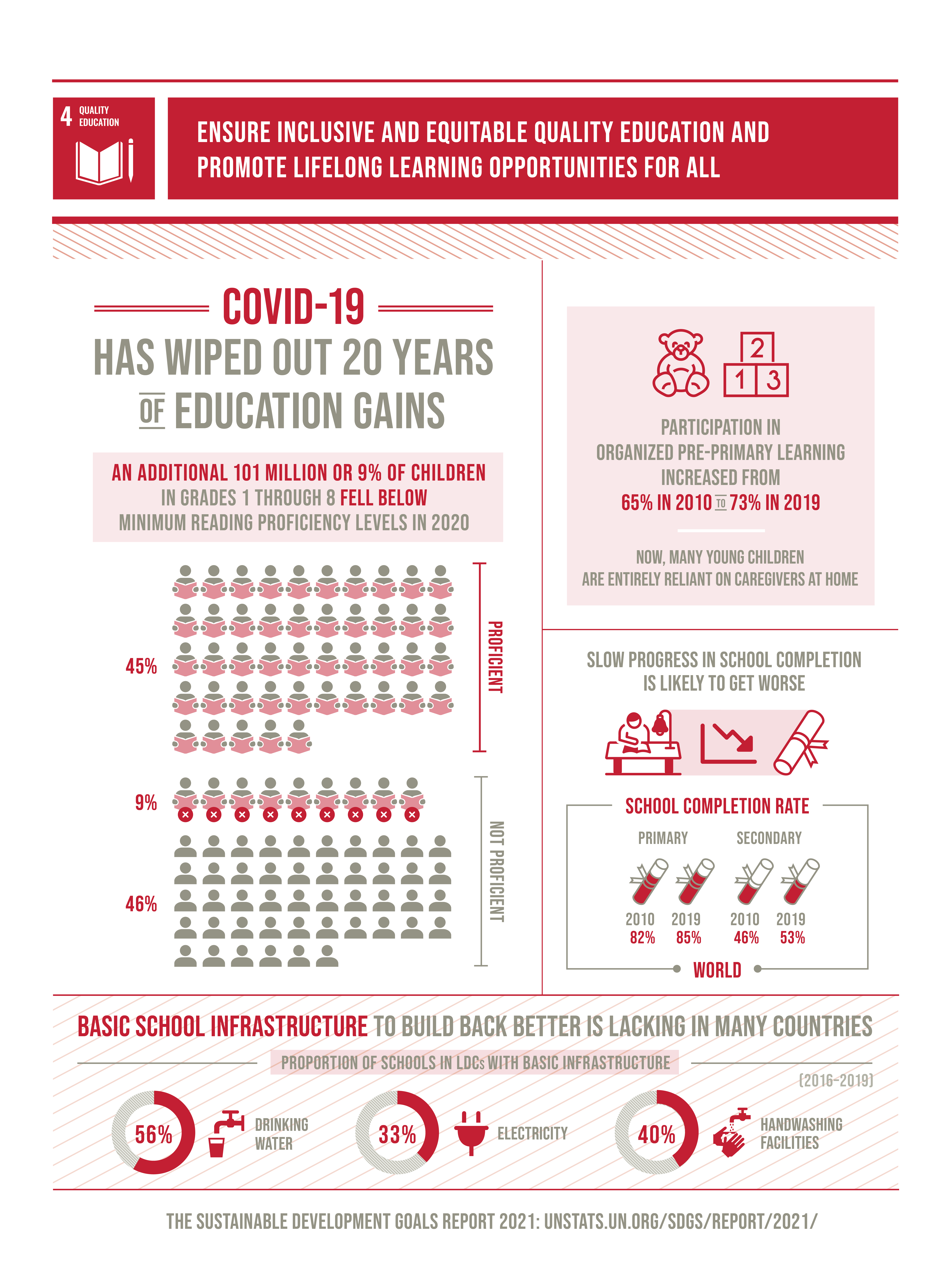



Over the past decade, major progress was made towards increasing access to education and school enrollment rates at all levels, particularly for girls. Nevertheless, about 260 million children were still out of school in 2018 — nearly one fifth of the global population in that age group. And more than half of all children and adolescents worldwide are not meeting minimum proficiency standards in reading and mathematics.
In 2020, as the COVID-19 pandemic spread across the globe, a majority of countries announced the temporary closure of schools, impacting more than 91 per cent of students worldwide. By April 2020, close to 1.6 billion children and youth were out of school. And nearly 369 million children who rely on school meals needed to look to other sources for daily nutrition.
Never before have so many children been out of school at the same time, disrupting learning and upending lives, especially the most vulnerable and marginalised. The global pandemic has far-reaching consequences that may jeopardize hard won gains made in improving global education.
Facts and Figures:-
- Before the coronavirus crisis, projections showed that more than 200 million children would be out of school, and only 60 per cent of young people would be completing upper secondary education in 2030.
- Before the coronavirus crisis, the proportion of children and youth out of primary and secondary school had declined from 26 per cent in 2000 to 19 per cent in 2010 and 17 per cent in 2018.
- More than half of children that have not enrolled in school live in sub-Saharan Africa, and more than 85 per cent of children in sub-Saharan Africa are not learning the minimum
- 617 million youth worldwide lack basic mathematics and literacy skills.
- Some 750 million adults – two thirds of them women – remained illiterate in 2016. Half of the global illiterate population lives in South Asia, and a quarter live in sub-Saharan Africa.
- In 10 low- and middle-income countries, children with disabilities were 19per cent less likely to achieve minimum proficiency in reading than those without disabilities.
- 4 million refugee children were out of school in 2017
4.1 By 2030, ensure that all girls and boys complete free, equitable and quality primary and secondary education leading to relevant and Goal-4 effective learning outcomes
4.2 By 2030, ensure that all girls and boys have access to quality early childhood development, care and preprimary education so that they are ready for primary education
4.3 By 2030, ensure equal access for all women and men to affordable and quality technical, vocational and tertiary education, including university
4.4 By 2030, substantially increase the number of youth and adults who have relevant skills, including technical and vocational skills, for employment, decent jobs and entrepreneurship
4.5 By 2030, eliminate gender disparities in education and ensure equal access to all levels of education and vocational training for the vulnerable, including persons with disabilities, indigenous peoples and children in vulnerable situations
4.6 By 2030, ensure that all youth and a substantial proportion of adults, both men and women, achieve literacy and numeracy
4.7 By 2030, ensure that all learners acquire the knowledge and skills needed to promote sustainable development, including, among others, through education for sustainable development and sustainable lifestyles, human rights, gender equality, promotion of a culture of peace and non-violence, global citizenship and appreciation of cultural diversity and of culture’s contribution to sustainable development
4.A Build and upgrade education facilities that are child, disability and gender sensitive and provide safe, nonviolent, inclusive and effective learning environments for all
4.B By 2020, substantially expand globally the number of scholarships available to developing countries, in particular least developed countries, small island developing States and African countries, for enrolment in higher education, including vocational training and information and communications technology, technical, engineering and scientific programmes, in developed countries and other developing countries
4.C By 2030, substantially increase the supply of qualified teachers, including through international cooperation for teacher training in developing countries, especially least developed countries and small island developing states
The impact of the COVID-19 pandemic on schooling is a “generational catastrophe”. Before the pandemic, progress was already slow and insufficient to achieve the education targets in the Goals. School closures caused by the pandemic have had devastating consequences for children’s learning and well-being. Hundreds of millions of children and young people are falling behind in their learning, which will have long-term impacts. One year into the COVID-19 crisis, two thirds of students worldwide are still affected by full or partial school closures. The most vulnerable children and those unable to access remote learning are at increased risk of never returning to school and of being forced into child marriage or child labour.
It is estimated that 101 million additional children and young people (from grades 1 to 8) fell below the minimum reading proficiency level in 2020 owing to the consequences of the pandemic, which wiped out the education gains achieved over the past 20 years. Reading proficiency levels could recover by 2024, but only if exceptional efforts are devoted to the task through remedial and catch-up strategies.
Just before the pandemic, 53 per cent of young people were completing secondary school globally, although the figure for sub-Saharan Africa was only 29 per cent. The rise in school completion rates may slow or even reverse depending on the duration of school closures, which are resulting in learning losses and affecting the motivation to attend school, and on the extent to which poverty might increase, adding to the obstacles faced by disadvantaged children.
Data from before the pandemic for 76 mostly low- and middle-income countries and territories covering the period 2012–2020 indicate that 7 in 10 children who are 3 and 4 years of age are on track developmentally, with no significant differences between the sexes. However, many young children are unable to attend early education because of the pandemic and so are now entirely reliant on their caregivers for nurturing care. Unsafe conditions, negative interactions with caregivers and a lack of educational opportunities during the early years can lead to irreversible outcomes, affecting children’s potential for the remainder of their lives.
The rate of participation in organized learning one year before the official age of entry into primary education rose steadily in the years before the pandemic, from 65 per cent in 2010 to 73 per cent in 2019, but with variation among countries and territories ranging from 12 per cent to nearly 100 per cent. Gender parity has been achieved in every region. The progress made over past years has been at risk since 2020 because early education facilities and primary schools closed in most countries and territories, preventing or limiting access to education, especially for children from low- and middle-income countries and territories.
Disparities in access to education and learning outcomes persist across a range of education indicators. For example, there were still only 92 literate women and girls 15 years of age or older for every 100 literate boys and men of the same ag e range in 2019. Almost half of countries and territories with recent data did not achieve gender parity in primary completion, and only a handful of countries and territories demonstrate parity in tertiary enrolment ratios. Disparities by urban/rural geographical location and household wealth are typically more extreme, with one third and one sixth of countries and territories achieving parity in primary completion, respectively, and no countries or territories with recent data achieving parity in tertiary attendance. The pandemic is expected to lead to a reversal in recent progress towards equity. With the shift towards remote learning, those from the poorest households and other vulnerable groups are less equipped to participate and more likely to drop out permanently or for extended periods.
According to data for the period from 2017 to 2019, more than one fifth of primary schools worldwide do not have access to basic drinking water, and more than one third lack basic handwashing facilities. In the least developed countries, more than two thirds of primary schools do not have access to electricity, with even lower rates of Internet access and computer availability for pedagogical purposes in schools.
ODA for scholarships amounted to $1.7 billion in 2019, up from $1.3 billion in 2017. The European Union, France, Japan, Saudi Arabia and Turkey accounted for 55 per cent of this total.
In 2019, 81 per cent of primary school teachers were trained, although that proportion was lower in sub-Saharan Africa (65 per cent) and Southern Asia (74 per cent). With the unprecedented lockdown as a result of the pandemic leading to total or partial school closures in most countries and territories, the teaching workforce was severely affected.
Sub-Saharan Africa faces the biggest challenges in providing schools with basic resources. The situation is extreme at the primary and lower secondary levels, where less than one half of schools in sub-Saharan Africa have access to drinking water, electricity, computers and the Internet. Inequalities will also worsen unless the digital divide – the gap between under-connected and highly digitalized countries – is not addressed.
Ask our governments to place education as a priority in both policy and practice. Lobby our governments to make firm commitments to provide free primary school education to all, including vulnerable or marginalized groups.
Source:- www.un.org